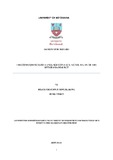The consequencies of language contact: a case study of the Setawana dialect

View/
Date
2016-07-14Author
Mogalakwe, Baagi G.
Link
UnpublishedType
Masters Thesis/DissertationMetadata
Show full item recordAbstract
The speech variety of Setawana (Setswana) which is spoken in Maun and the whole of the Ngamiland region, has borrowed lexical items from ethnic groups’ languages in their surroundings. In the light of this situation, this study aimed to: investigate which new vocabulary have been acquired in Setawana as compared to standard Setswana, find out the type of vocabulary that is mostly affected by this adoption, and finally determine the extent to which language contact has affected Setawana speakers’ communicative skills especially the younger generation. The information was gathered through participant observation, questionnaire and interview methods. For participant observation, the author of this dissertation participated in funeral processions, wedding celebrations and kgotla meetings and other communicative events. Interviewees for this project included the chief, village elders and some youths in the area under study.
The study proved that much as Setawana dialect is a variety of Setswana language, it has retained its basic cultural and environmental vocabulary. The results of the study showed that a lexical expansion of Setawana due to intensive borrowing of cultural and environmental vocabulary from other ethnic groups’ languages in the area. The findings also showed that the youth were mostly code-switching and code-mixing ostensibly to align their verbalinteractions with Setswana standard orthography taught at schools and be able to interact with children from different ethnic groups in the area. Furthermore, the findings showed that other ethnic groups in the area are bilingual and they mostly code-switch and code-mix when they do not know some words in Setswana. Their accent and pronunciation has influenced the Setawana dialect speakers accent because they out number them. The other factor that contributed to massive borrowing of vocabulary from other languages is the geographical location and isolation from other Setswana speakers.
It could therefore be concluded that geographical location, isolation from other Setswana speakers, contact with other languages like Sheyeyi, Thimbukushu, Otjiherero and others contribute to borrowing of vocabulary and bilingualism which in turn contributed to Setawana speakers’ accent being affected or changed. This has also affected the young generation communicative skills as they are to emulate their parents while at the same time are learning standard Setswana which is a compulsory subject government schools.
